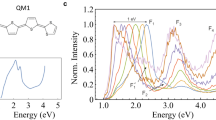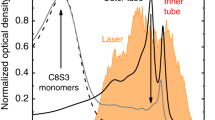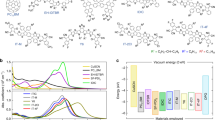Abstract
One of the challenges for achieving efficient exciton transport in solar energy conversion systems is precise structural control of the light-harvesting building blocks. Here, we create a tunable material consisting of a connected chromophore network on an ordered biological virus template. Using genetic engineering, we establish a link between the inter-chromophoric distances and emerging transport properties. The combination of spectroscopy measurements and dynamic modelling enables us to elucidate quantum coherent and classical incoherent energy transport at room temperature. Through genetic modifications, we obtain a significant enhancement of exciton diffusion length of about 68% in an intermediate quantum-classical regime.
This is a preview of subscription content, access via your institution
Access options
Subscribe to this journal
Receive 12 print issues and online access
$259.00 per year
only $21.58 per issue
Buy this article
- Purchase on Springer Link
- Instant access to full article PDF
Prices may be subject to local taxes which are calculated during checkout





Similar content being viewed by others
References
Wasielewski, M. R. Self-assembly strategies for integrating light harvesting and charge separation in artificial photosynthetic systems. Acc. Chem. Res. 42, 1910–1921 (2009).
Goodson, T. G. Optical excitations in organic dendrimers investigated by time-resolved and nonlinear optical spectroscopy. Acc. Chem. Res. 38, 99–107 (2005).
Eisele, D. M. et al. Utilizing redox-chemistry to elucidate the nature of exciton transitions in supramolecular dye nanotubes. Nature Chem. 4, 655–662 (2012).
Woller, J. G., Hannestad, J. K. & Albinsson, B. Self-assembled nanoscale DNA-porphyrin complex for artificial light harvesting. J. Am. Chem. Soc. 135, 2759–2768 (2013).
Miller, R. A., Presley, A. D. & Francis, M. B. Self-assembling light-harvesting systems from synthetically modified tobacco mosaic virus coat proteins. J. Am. Chem. Soc. 129, 3104–3109 (2007).
Ma, Y. Z., Miller, R. A., Fleming, G. R. & Francis, M. B. Energy transfer dynamics in light-harvesting assemblies templated by the tobacco mosaic virus coat protein. J. Phys. Chem. B 112, 6887–6892 (2008).
Nam, Y. S. et al. Virus-templated assembly of porphyrins into light-harvesting nanoantennae. J. Am. Chem. Soc. 132, 1462–1463 (2010).
Lee, Y. J. et al. Fabricating genetically engineered high-power lithium-ion batteries using multiple virus genes. Science 324, 1051–1055 (2009).
Dang, X. N. et al. Virus-templated self-assembled single-walled carbon nanotubes for highly efficient electron collection in photovoltaic devices. Nature Nanotech. 6, 377–384 (2011).
Nam, Y. S. et al. Biologically templated photocatalytic nanostructures for sustained light-driven water oxidation. Nature Nanotech. 5, 340–344 (2010).
Nam, Y. S. et al. Virus-templated iridium oxide-gold hybrid nanowires for electrochromic application. Nanoscale 4, 3405–3409 (2012).
Ghosh, D. et al. M13-templated magnetic nanoparticles for targeted in vivo imaging of prostate cancer. Nature Nanotech. 7, 677–682 (2012).
Engel, G. S. et al. Evidence for wavelike energy transfer through quantum coherence in photosynthetic systems. Nature 446, 782–786 (2007).
Olaya-Castro, A., Lee, C. F., Fassioli Olsen, F. & Johnson, N. F. Efficiency of energy transfer in a light-harvesting system under quantum coherence. Phys. Rev. B 78, 085115 (2008).
Caruso, F., Chin, A. W., Datta, A., Huelga, S. F. & Plenio, M. B. Highly efficient energy excitation transfer in light-harvesting complexes: The fundamental role of noise-assisted transport. J. Chem. Phys. 131, 105106 (2009).
Rebentrost, P., Mohseni, M., Kassal, I., Lloyd, S. & Aspuru-Guzik, A. Environment-assisted quantum transport. New J. Phys. 11, 033003 (2009).
Walschaers, M., Diaz, J. F., Mulet, R. & Buchleitner, A. Optimally designed quantum transport across disordered networks. Phys. Rev. Lett. 111, 180601 (2013).
Blankenship, R. E. Molecular Mechanisms of Photosynthesis (Blackwell Science, 2002).
Scholes, G. D., Fleming, G. R., Olaya-Castro, A. & van Grondelle, R. Lessons from nature about solar light harvesting. Nature Chem. 3, 763–774 (2011).
Panitchayangkoon, G. et al. Long-lived quantum coherence in photosynthetic complexes at physiological temperature. Proc. Natl Acad. Sci. USA 107, 12766–12770 (2010).
Marvin, D. A., Welsh, L. C., Symmons, M. F., Scott, W. R. P. & Straus, S. K. Molecular structure of fd (f1, M13) filamentous bacteriophage refined with respect to X-ray fibre diffraction and solid-state NMR data supports specific models of phage assembly at the bacterial membrane. J. Mol. Biol. 355, 294–309 (2006).
Lankiewicz, L., Malicka, J. & Wiczk, W. Fluorescence resonance energy transfer in studies of inter-chromophoric distances in biomolecules. Acta Biochim. Pol. 44, 477–489 (1997).
Turro, N. J., Ramamurthy, V. & Scaiano, J. C. Modern Molecular Photochemistry of Organic Molecules (Univ. Science Books, 2010).
Spence, M. T. Z. & Johnson, I.D. The Molecular Probes Handbook: A Guide to Fluorescent Probes and Labeling Technologies 11th edn (Live Technologies Corporation, 2010).
Haken, H. & Reineker, P. Coupled coherent and incoherent motion of excitons and its influence on line shape of optical-absorption. Z. Phys. 249, 253–268 (1972).
Haken, H. & Strobl, G. Exactly solvable model for coherent and incoherent exciton motion. Z. Phys. 262, 135–148 (1973).
Christensson, N., Kauffmann, H. F., Pullerits, T. & Mancal, T. Origin of long-lived coherences in light-harvesting complexes. J. Phys. Chem. B 116, 7449–7454 (2012).
Tiwari, V., Peters, W. K. & Jonas, D. M. Electronic resonance with anticorrelated pigment vibrations drives photosynthetic energy transfer outside the adiabatic framework. Proc. Natl Acad. Sci. USA 110, 1203–1208 (2013).
Halpin, A. et al. Two-dimensional spectroscopy of a molecular dimer unveils the effects of vibronic coupling on exciton coherences. Nature Chem. 6, 196–201 (2014).
Huang, Y. et al. Programmable assembly of nanoarchitectures using genetically engineered viruses. Nano Lett. 5, 1429–1434 (2005).
Lapini, A., Foggi, P., Bussotti, L., Righini, R. & Dei, A. Relaxation dynamics in three polypyridyl iron(II)-based complexes probed by nanosecond and sub-picosecond transient absorption spectroscopy. Inorg. Chim. Acta 361, 3937–3943 (2008).
Marcelli, A., Foggi, P., Moroni, L., Gellini, C. & Salvi, P. R. Excited-state absorption and ultrafast relaxation dynamics of porphyrin, diprotonated porphyrin, and tetraoxaporphyrin dication. J. Phys. Chem. A 112, 1864–1872 (2008).
Gentili, P. L., Bussotti, L., Ruzziconi, R., Spizzichino, S. & Foggi, P. Study of the photobehavior of a newly synthesized chiroptical molecule: (E)-(R-p, R-p)-1,2-Bis{4-methyl-[2]paracyclo[2](5,8)quinolinophan-2-yl}ethene. J. Phys. Chem. A 113, 14650–14656 (2009).
May, V. & Kühn, O. Charge and Energy Transfer Dynamics in Molecular Systems 2nd edn (Wiley-VCH, John Wiley, 2004).
Forster, T. ∗Zwischenmolekulare Energiewanderung Und Fluoreszenz. Ann. Phys. 2, 55–75 (1948).
Sener, M. K. et al. Excitation migration in trimeric cyanobacterial photosystem I. J. Chem. Phys. 120, 11183–11195 (2004).
Breuer, H.-P. & Petruccione, F. The Theory of Open Quantum Systems (Oxford Univ. Press, 2002).
Acknowledgements
This work was supported from Eni, S.p.A. (Italy) through the MIT Energy Initiative Program. H.P. thanks Kwanjeong Educational Foundation for its financial support, and G. W. Hwang for allowing us to use a fluorometer. F.C. has been supported by EU FP7 Marie-Curie Programme (Career Integration Grant) and by MIUR-FIRB grant (Project No. RBFR10M3SB).
Author information
Authors and Affiliations
Contributions
H.P., N.H., P.F.S., M.M., R.F., S.L. and A.M.B. conceived the work. P.F.S., P.F., S.L. and A.M.B. supervised the overall work. H.P. and N.H. designed the experiments including protocols. H.P. prepared all the samples, performed the spectroscopic measurements, analysed the data, and interpreted the data with classical Förster theory. H.P. wrote a first version of the manuscript, based on which H.P., P.R. and N.H. developed the final version of the manuscript. H.P. and N.H. reconstructed the virus structure models, and performed the virus cloning. P.F.S. and R.F. made collaborations between MIT and Italy. P.R., P.F.S., L.A., M.M., R.F. and S.L. designed the theoretical work. P.R. and S.L. developed the fluorescence theory, and P.R. and H.P. applied it to the data. P.R. and S.L. developed the quantum transport theory, and P.R. and L.A. performed the quantum mechanical simulations. A.I., B.P., L.B. and P.F. performed the TA measurements and analysed the TA data. P.F., A.I. and H.P. interpreted the TA data. M.S. and R.F. helped H.P., N.H. and A.A. perform the QY measurements, and H.P. and A.A. analysed the QY data. F.C. collaborated in developing the computation model. H.C.J. helped H.P. with the virus preparations. H.P., N.H., P.R., P.F.S., S.L. and A.M.B. made major edits on the manuscript. All the authors gave helpful comments on the manuscript.
Corresponding authors
Ethics declarations
Competing interests
The authors declare no competing financial interests.
Supplementary information
Supplementary Information
Supplementary Information (PDF 8221 kb)
Rights and permissions
About this article
Cite this article
Park, H., Heldman, N., Rebentrost, P. et al. Enhanced energy transport in genetically engineered excitonic networks. Nature Mater 15, 211–216 (2016). https://doi.org/10.1038/nmat4448
Received:
Accepted:
Published:
Issue Date:
DOI: https://doi.org/10.1038/nmat4448
This article is cited by
-
A framework for multiexcitonic logic
Nature Reviews Chemistry (2024)
-
Amino-acids-functionalized M13-assisted synthesis of silver and silver sulfide nanoparticles
Rare Metals (2023)
-
Interfacing DNA nanotechnology and biomimetic photonic complexes: advances and prospects in energy and biomedicine
Journal of Nanobiotechnology (2022)
-
Quantum tunnelling in the context of SARS-CoV-2 infection
Scientific Reports (2022)
-
Designing and understanding light-harvesting devices with machine learning
Nature Communications (2020)



